Have you noticed how the shelf at the hardware store with the woodworking router bits is massive, and overloaded with options?
There are all kinds of router bits available to buy, but many of them are not critical, and serve a very specific purpose, which may not be helpful to you at all.
In my experience with woodworking, I’ve found that there are just a handful of critical and practical router bits for any given project or joinery type.
So I want to share with you my short list of practical and important woodworking router bits, so hopefully you can stop with the confusion and start with some routing.
First, I’ll give you a quick list with a few notes. Further down, I’ll explain each type of router bit in more detail.
- Straight Cutting Bit – A good multi-purpose bit for things like grooves, dadoes, box joints, template cutting, and more.
- Round Over Bit – Decorative and utilitarian, it makes the edges of any project look better, while removing sharp, splintering corners.
- Flush Trim Bit – Ideal for working with guides and templates.
- Up-Cut Spiral Bit – Similar to the straight cut, but better for plunge-routing, and it has better chip extraction.
- Rabbeting Bit – Produces different sizes of rabbets, very cleanly and accurately.
>> Note on bit selection: Most bits come with either carbide tipped blades, or HSS (high speed steel). If you have a choice, opt for the carbide blades. These will hold a sharp edge much longer than HSS blades, as the carbide is a harder material. It’s more brittle though, so take good care of your bits when storing them.
Straight Cutting Bit
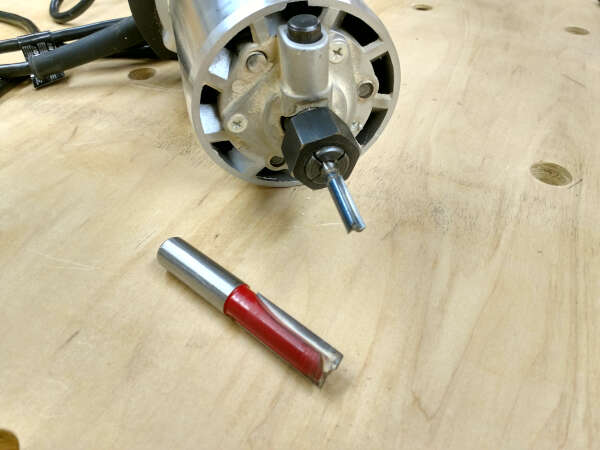

A straight cutting router bit is a good, well-rounded general use bit with many purposes.
One of my favorite uses for my straight cutting bits is when using a template with a guide bushing. This works for plunge-routing grooves and dados, and inlay patterns.
>> Click here to see how to inlay patterns using a router
Using a guide bushing and a straight bit can also work for flattening the edge of a large board, which is a great alternative when you don’t have a jointer.
>> Click here to see how to use a router as a jointer
I would suggest getting straight cutting bits from 1/8″ up to 1/2″.
Round Over Bit
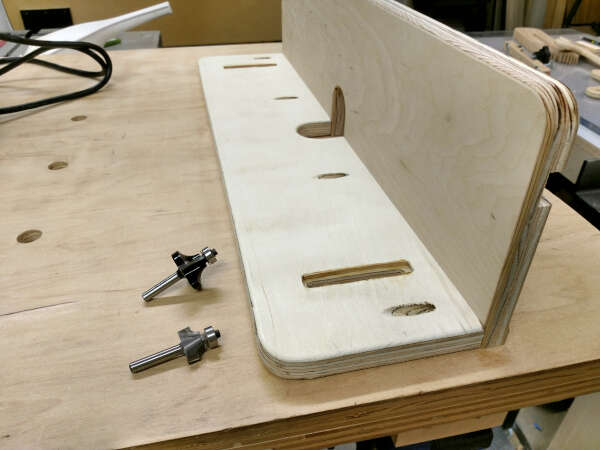

The round over bit is an incredibly simple and effective way to soften the edges. It’s a great woodworking router bit for all kinds of projects.
These are ideal for shop jigs and sleds, as these projects are typically made from plywood and freshly sawn plywood may have sharp, splintering edges.
Rounding these over makes your jigs and sleds much easier to handle and work with.
Round over routing is also good for projects like beds, table tops, toys, and anything else that will be coming in contact with hands often.
I would recommend getting a few different sizes of the round over bit, from 1/8″ radius up to 3/4″ radius.
Flush Trim Bit
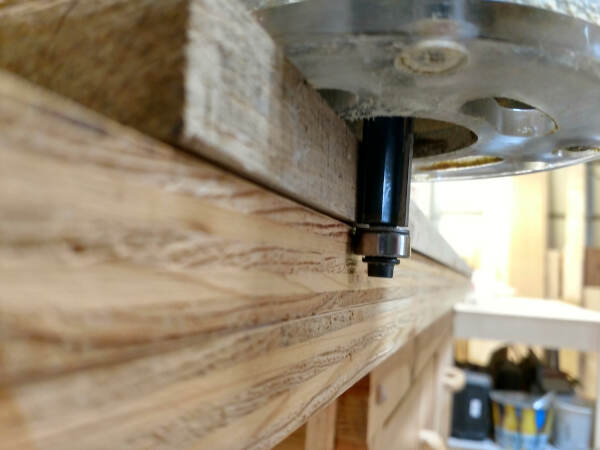

A flush trim router bit can take the place of the straight bit plus guide bushing, in some cases.
The flush trim bit has a guide bearing on the end of the bit. This bearing keeps the cutting part of the bit perfectly in line with whatever the bearing is riding against.
That means templates, different types of router jointing, and cleaning up laminated and veneered edges.
I’ve found that my 1/2″ flush trim router bit is most often good enough for any trim job.
Up-Cut Spiral Woodworking Router Bit
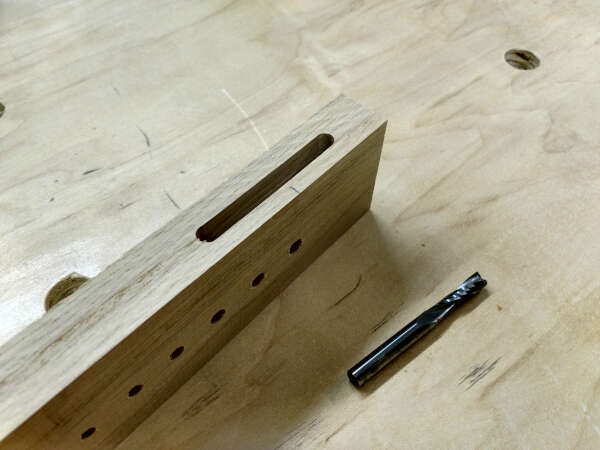

Spiral bits work very similar to straight cutting bits, but they’re better suited for plunge-routing non-through holes, like grooves and mortises.
The spiral action pulls the wood chips up and out of the mortise, for example.
These are ideal when using things like a router mortising jig for doing standard mortise and tenon, or loose tenon joinery.
I would suggest getting at least a 1/4” diameter spiral bit, that way you can plunge 1/4” mortises and grooves, and larger. Getting bigger spiral bits will simply make quicker work of routing bigger mortises and grooves.
>> Click here to see my router mortising jig in action
Rabbeting Router Bit
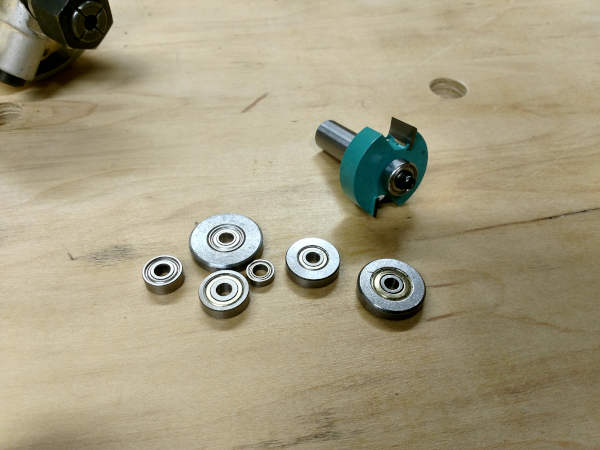

In many cases, the table saw can and should handle cutting your rabbets (“rebates” for our friends across the pond).
But a good rabbeting bit set up in your router table can produce cleaner rabbets than a standard table saw blade, or a stacked dado blade set.
Another benefit of setting up your router to do your rabbets is that it leaves your table saw open to continue making your rip cuts and cross cuts.
Plus, sometimes you need a rabbet on a large piece of wood, and it can be awkward or unsafe to make the cut on the table saw.
So you can use your handheld router to cut the rabbet while leaving the board stationary and clamped in place.
A good rabbeting bit set will have different sizes of bearings you can attach, to control the width of the rabbet. The depth of the rabbet will be controlled by the height of the router bit set in the table, or the plunge depth on your router base.
Shank Size And Collets
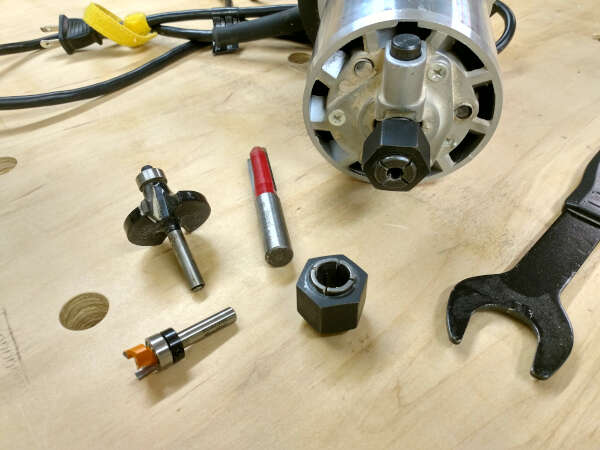

The shank is the solid, cylindrical shaft to which the cutter head of the bit is attached.
The collet is the compression-style nut on the end of the router, which tightens down onto the bit shank.
Many routers comes with interchangeable collets, supporting both a 1/4” shank, and a 1/2” shank. When choosing a router, I would suggest getting one which does just that.
And when choosing your router bits, sometimes they’ll only come with a 1/4” shank, other times only 1/2”. But many types of bits are offered in both.
So if you have a choice, go with the router bits that have a 1/2” shank. These are more stable and will have less vibration, producing cleaner cuts.
Other Helpful Woodworking Router Bits
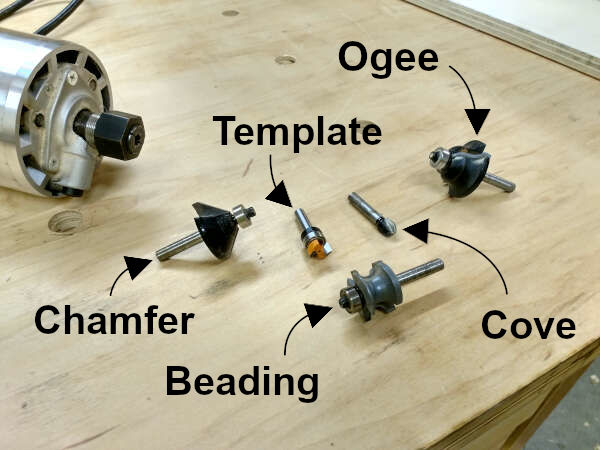

45 Degree Chamfer Bit
Mostly for a simple decorative edge profile, the chamfer bits can also be used simply to break the corners of freshly cut wood.
Decorative Edge Forming Bits
This would include the Ogee bit, which produces various types of S-shaped profiles. Also the Beading bit which makes a half-circle profile. These typically have a bearing on the end, but you can also set the depth of the cut using your router table’s fence.
Cove Bit
Another decorative bit for adding some unique design features to your projects. This bit leaves a concave quarter-circle profile, and can be applied to edges or to board faces.
Template Cutting Bit
A utilitarian bit perfect for door hinge mortising, sign making templates, and cleaning up between the pins for dovetail joinery. This bit is similar to the flush-trim bit, but the bearing is closest to the router (instead of out at the end of the blade), and the blade is often much shorter than that of a flush trim bit.
Specialty Router Bits & Max Speed
Specialty woodworking router bits typically serve a single purpose, and some of them will even come in pairs.
Some specialty bits are small and inexpensive, like Dovetail bits and Keyhole Slot bits.
But others are bulky, heavy, and expensive. This would include the Stile & Rail bit set, which produces matching profiles that works as the interlocking joinery between the rails and stiles for framed panel doors.
There’s also Raised Panel bits, which create the decorative beveled edge of a flat panel, to be installed in the raised panel door.
When using large diameter bits like these, I would only suggest using them with a 1/2” shank, and only with a variable speed router.
When you purchase the bit, it’s labeling should give you a maximum rpm (revolutions per minute), beyond which is the speed the bit will become unstable and cause vibration.
So if you plan on routing with large, heavy specialty bits, be sure to get a variable speed router.
And if you’re unsure on max speed for a given woodworking router bit, just remember that the larger diameter the bit is, the slower it should turn.
Read the instructions with your router to better understand the speed settings, and the general rpm suggestions based on router bit diameter.
Please click the Facebook or Pinterest buttons to help spread the word. And be sure to sign up below to get some great woodworking stuff straight to your inbox!
Related:
Straight Cut Bit and Flush Trim Bit Being Used As A Jointer
Router Mortising Jig Using Up-Cut Spiral Bit
Straight Cut Bit With Pattern Template For Inlay